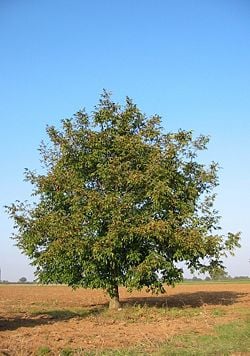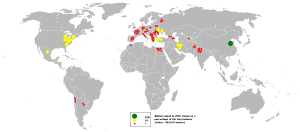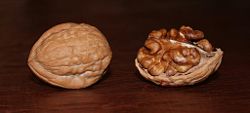Walnut
| Walnuts | ||||||||||||
|---|---|---|---|---|---|---|---|---|---|---|---|---|
 Persian Walnut, Juglans regia
| ||||||||||||
| Scientific classification | ||||||||||||
| ||||||||||||
|
See text |
Walnuts (genus Juglans) are plants in the family Juglandaceae. They are deciduous trees, 10 - 40 metres tall (about 30-130 ft.), with pinnate leaves 200 - 900 millimetres long (about 7-35 inches), with 5 - 25 leaflets; the shoots have chambered pith, a character shared with the wingnuts (Pterocarya) but not the hickories (Carya) in the same family.
The 21 species in the genus range across the north temperate Old World from southeast Europe east to Japan, and more widely in the New World from southeast Canada west to California and south to Argentina. The Latin name Juglans derives from Jovis glans, "Jupiter's acorn": figuratively, a nut fit for a god.
The word walnut derives from Old English wealhhnutu, literally "foreign nut", wealh meaning "foreign" (wealh is akin to the terms Welsh and Vlach; see *Walha and History of the term Vlach). The walnut was so called because it was introduced from Gaul and Italy. The previous Latin name for the walnut was nux Gallica, "Gallic nut".
Species and classification
- Sect. Juglans. Leaves large (20-45 cm) with 5-9 broad leaflets, hairless, margins entire. Wood hard. Southeast Europe to central Asia.
- Juglans regia L. (J. duclouxiana Dode, J. fallax Dode, J. orientis Dode) - Persian Walnut, Carpathian, or Common Walnut
- Juglans sigillata Dode - Iron Walnut (doubtfully distinct from J. regia)
- Sect. Rhysocaryon. Leaves large (20-50 cm) with 11-23 slender leaflets, finely pubescent, margins serrated. Wood hard. North America, South America.
- Juglans australis Griseb. (J. boliviana Dode) - Argentine Walnut
- Juglans brasiliensis Dode - Brazilian Walnut
- Juglans californica S.Wats. - California Walnut
- Juglans hindsii (Jepson) R.E.Smith - Hinds' Walnut
- Juglans hirsuta Manning - Nuevo Leon Walnut
- Juglans jamaicensis C.DC. (J. insularis Griseb.) - West Indies Walnut
- Juglans major (Torrey) Heller (J. arizonica Dode, J. elaeopyron Dode, J. torreyi Dode) - Arizona Walnut
- Juglans major var. glabrata Manning
- Juglans microcarpa Berlandier (J. rupestris Engelm.) - Texas Walnut or Little Walnut
- Juglans microcarpa var. stewartii (Johnston) Manning
- Juglans mollis Engelm. - Mexican Walnut
- Juglans neotropica Diels (J. honorei Dode) - Andean Walnut
- Juglans nigra L. - Black Walnut
- Juglans olanchana Standl. & L.O.Williams -
- Juglans peruviana Dode - Peruvian Walnut
- Juglans soratensis Manning -
- Juglans steyermarkii Manning - Guatemalan Walnut
- Juglans venezuelensis Manning - Venezuela Walnut
- Sect. Cardiocaryon. Leaves very large (40-90 cm) with 11-19 broad leaflets, softly downy, margins serrated. Wood soft. Northeast Asia, eastern North America.
- Juglans ailantifolia Carr. (J. cordiformis Maxim., J. sieboldiana Maxim.) - Japanese Walnut
- Juglans cinerea L. - Butternut
- Juglans mandschurica Maxim. (J. cathayensis Dode, J. formosana Hayata, J. hopeiensis Dode, J. stenocarpa Maxim.) - Chinese Walnut or Manchurian Walnut
The best-known member of the genus is the Persian Walnut (Juglans regia), native from the Balkans in southeast Europe, southwest & central Asia to the Himalaya and southwest China.
The scientific name Juglans is from the Latin jovis glans, "Jupiter's nut", and regia, "royal". Its common name, Persian walnut, indicates its origins in Persia (Iran) in southwest Asia; 'walnut' derives from the Germanic wal- for "foreign", recognising that it is not a nut native to northern Europe. In Kyrgyzstan alone there are 230,700 ha of walnut-fruit forest, where J. regia is the dominant overstorey (Hemery and Popov 1998). This is the species which is widely cultivated for its delicious nuts. J. regia is also called English walnut because English merchant marines once controlled its world commerce.
The Black Walnut (Juglans nigra) is a common species in its native eastern North America, and is also widely cultivated elsewhere. The nuts are edible, but have a smaller kernel and an extremely tough shell, and they are not widely grown for nut production.
The Butternut (Juglans cinerea) is also native to eastern North America, where it is currently endangered by an introduced disease, butternut canker, caused by the fungus Sirococcus clavigignenti. Its leaves are 40-60 cm long, and the nuts oval.
The Japanese Walnut (Juglans ailantifolia) is similar to Butternut, distinguished by the larger leaves up to 90 cm long, and round (not oval) nuts.
- Hybrids
- Juglans x bixbyi Rehd. - J. ailantifolia x J. cinerea
- Juglans x intermedia Carr. - J. nigra x J. regia
- Juglans x notha Rehd. - J. ailantifolia x J. regia
- Juglans x quadrangulata (Carr.) Rehd. - J. cinerea x J. regia
- Juglans x sinensis (D. C.) Rehd. - J. mandschurica x J. regia
- Juglans x paradox Burbank - J. hindsii x J. regia
- Juglans x royal Burbank - J. hindsii x J. nigra
Cultivation and uses
The two most commercially important species are J. regia for timber and nuts, and J. nigra for timber. Both species have similar cultivation requirements and are widely grown in temperate zones.
Walnuts are light-demanding species that benefit from protection from wind. Walnuts are also very hardy against drought.
Interplanting walnut plantations with a nitrogen fixing plant such as Elaeagnus × ebbingei or E. umbellata, and various Alnus species results in a 30% increase in tree height and girth (Hemery 2001).
When grown for nuts care must be taken to select cultivars that are compatible for pollination purposes, although some cultivars are marketed as "self fertile" they will generally fruit better with a different pollination partner. There are many different cultivars available for growers, offering different growth habit, flowering and leafing, kernel flavour and shell thickness. A key trait for more northerly latitudes of N. America and Europe is phenology, with ‘late flushing’ being particularly important to avoid frost damage in Spring. Some cultivars have been developed for novel ‘hedge’ production systems developed in Europe and would not suit more traditional orchard systems.
Nuts
The nuts of all the species are edible, but the walnuts commonly available in stores are from the Persian Walnut, the only species which has a large nut and thin shell. A horticultural form selected for thin nut shells and hardiness in temperate zones is sometimes known as the 'Carpathian' walnut. The nuts are rich in oil, and are widely eaten both fresh and in cookery. Walnut oil is expensive and consequently is used sparingly; most often in salad dressing. Oil paint also often employs walnut oil as an effective binding medium, known for its clear, glossy consistency and non-toxicity. Walnuts are also an excellent source of omega-3 fatty acids, and have been shown as helpful in lowering cholesterol. They need to be kept dry and refrigerated to store well; in warm conditions they become rancid in a few weeks, particularly after shelling.
In some countries immature nuts in their husks are preserved in vinegar. In England these are called "pickled walnuts" and this is one of the major uses for fresh nuts from the small scale plantings. In Armenian cuisine, walnuts are preserved in sugar syrup and eaten whole. In Italy, liqueurs called Nocino and Nocello are flavoured with walnuts. In Georgia, walnuts are ground along with other ingredients to make walnut sauce.
Walnuts are heavily used in India. In Jammu, India it is used widely as a prasad (offering) to Mother Goddess Vaisnav Devi and, generally, as a dry food in the season of festivals such as Diwali.
Walnut husks are often used to create a rich yellow-brown to dark brown dye that is used for dyeing fabric and for other purposes. When picking walnuts, the husks should be handled wearing rubber gloves, to avoid dyeing one's fingers.
Wood
The Persian Walnut, and the Black Walnut and its allies, are important for their attractive timber, which (except in young trees) is hard, dense, tight-grained and polishes to a very smooth finish. The colour ranges from creamy white in the sapwood to a dark chocolate colour in the heartwood. When kiln-dried, walnut wood tends toward a dull brown colour, but when air-dried can become a rich purplish-brown. Because of its colour, hardness and grain it is a prized furniture and carving wood. Walnut burls (or 'burrs' in Europe) are commonly used to create bowls and other turned pieces. Veneer sliced from walnut burl is one of the most valuable and highly prized by cabinet makers and prestige car manufacturers. Walnut wood has been the timber of choice for gun makers for centuries, including the Lee Enfield rifle of the First World War. Today it is used for exclusive sporting guns, by makers such as Purdey of London. The wood of the Butternut and related Asian species is of much lower value, softer, coarser, less strong and heavy, and paler in color.
In North America research has been undertaken mostly on Juglans nigra aiming to improve the quality of planting stock and markets. The Walnut Council is the key body linking growers with scientists. In Europe, various EU-led scientific programs have studied walnut growing for timber (e.g. in the UK).
Parkland and garden trees
Walnuts are very attractive trees in parks and large gardens. The Japanese Walnut in particular is grown for its huge leaves, which have a 'tropical' appearance.
Walnuts are not particularly well suited to smaller urban gardens. They drop numerous small twigs, leaves, branches or nuts, so are considered "messy" by some people; the falling nuts in late summer and early autumn can be quite dangerous. Both the fallen leaves and the roots secrete a substance called juglone which kills many popular garden plants, such as tomato, apple and birch; all walnuts produce juglone, but Black Walnut produces larger amounts than other species. Juglone appears to be one of the walnut's primary defence mechanisms against potential competitors for resources (water, nutrients and sunlight), and its effects are felt most strongly inside the tree's "drip line" (the circle around the tree marked by the horizontal distance of its outermost branches). However, even plants at a seemingly great distance outside the drip line can be affected, and juglone can linger in the soil for many years even after a walnut is removed as its roots slowly decompose and release juglone into the soil. In addition, walnuts are a popular snack among woodland creatures, specifically mice.
Walnut leaves as food plants
Walnuts are used as food plants by the larvae of some Lepidoptera species. These include:
- Brown-tail (Euproctis chrysorrhoea)
- the Coleophora case-bearers C. laticornella (recorded on J. nigra) and C. pruniella.
- Common Emerald (Hemithea aestivaria)
- Emperor Moth (Pavonia pavonia)
- The Engrailed (Ectropis crepuscularia)
- Walnut Sphinx (Amorpha juglandis)
Health benefits of walnuts
A new study published in the Journal of the American College of Cardiology found that eating walnuts after a meal high in unhealthy fats can reduce the damaging effects of such fats on blood vessels. Researchers from Barcelona's Hospital Clinic conducted a study on 24 adult participants, half of whom had normal cholesterol levels, and half of whom had moderately high levels of cholesterol. Each group was fed two high-fat meals of salami and cheese, eaten one week apart. During one meal, the researchers supplemented the food with five teaspoons of olive oil. The researcher added eight shelled walnuts to the other meal, the following week.
Tests after each meal showed that both the olive oil and the walnuts helped reduce the onset of dangerous inflammation and oxidation in the arteries after the meals, which were high in saturated fat. However, unlike the olive oil, the walnuts also helped the arteries maintain their elasticity and flexibility, even in the participants with higher cholesterol.
Lead researcher Dr. Emilio Ros said walnuts' protective effects could be because the nuts are high in antioxidants and ALA, a plant-based omega-3 fatty acid. Walnuts also contain arginine, which is an amino acid that the body uses to produce nitric oxide, necessary for keeping blood vessels flexible.
Source: Journal of the American College of Cardiology - Oct. 17, 2006 edition
Walnut extract and Alzheimer's
A study by the NYS Institute for Basic Research in Developmental Disabilities found that walnut extract was able to inhibit and defibrillize (break down) fibrillar amyloid beta protein - the principal component of amyloid plaques in the brains of patients with Alzheimer's. The study looked at the effect of walnut extract on amyloid beta protein fibrillization by Thioflavin T fluorescence spectroscopy and electron microscopy.
These results suggest that walnuts may reduce the risk or delay the onset of Alzheimer's disease by maintaining amyloid beta protein in the soluble form.
Source: Current Alzheimer Research, Volume 1, Number 3, August 2004, pp. 183-188(6)
Walnuts in Chinese medicine
In Traditional Chinese Medicine, walnut seeds are primarily considered a kidney tonic. They are also considered beneficial to the brain, back, and skin, and to relieve constipation if it is caused by dehydration.
External links
- Extensive information about walnuts and how to grow them
- Informations about history, processing and health
- Juglone toxicity
- Flora of Bolivia: Juglans
- Flora of China: Juglans
- Flora Europaea: Juglans
- Flora of North America: Juglans
- Flora of Pakistan: Juglans
- Trees of the Andes: Juglans
- BBC article lead to a reported 80% increase in demand at Waitrose. (ref. radio 4 news).
- Walnut growing for timber research in the UK
- Walnut Extract Inhibits the Fibrillization of Amyloid Beta-Protein, and also Defibrillizes its Preformed Fibrils
Credits
New World Encyclopedia writers and editors rewrote and completed the Wikipedia article in accordance with New World Encyclopedia standards. This article abides by terms of the Creative Commons CC-by-sa 3.0 License (CC-by-sa), which may be used and disseminated with proper attribution. Credit is due under the terms of this license that can reference both the New World Encyclopedia contributors and the selfless volunteer contributors of the Wikimedia Foundation. To cite this article click here for a list of acceptable citing formats.The history of earlier contributions by wikipedians is accessible to researchers here:
The history of this article since it was imported to New World Encyclopedia:
Note: Some restrictions may apply to use of individual images which are separately licensed.








